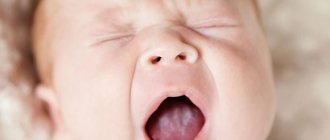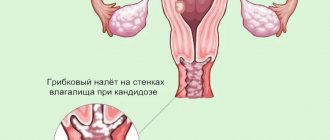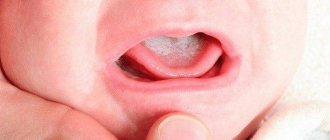Oral thrush is a disease that often occurs in newborns, infants and older children. It is also called candidiasis, because it is caused by yeast flora - microorganisms of the genus Candida. Thrush is a fungal infection that affects the mucous membrane of the mouth and causes very unpleasant and even painful sensations. The disease occurs in acute and chronic forms. The sooner you start treating oral thrush in children, the easier it will be to cope with the disease and avoid complications.
Nosological classification (ICD-10)
- B37.0 Candidal stomatitis
- K00.7 Teething syndrome
- K05 Gingivitis and periodontal diseases
- K12 Stomatitis and related lesions
- K13.0 Diseases of the lips
- K13.7 Other and unspecified lesions of the oral mucosa
- L43.9 Lichen planus, unspecified
- L51.9 Erythema multiforme, unspecified
- Z100* CLASS XXII Surgical practice
- Z97.2 Presence of dental prosthetic device (complete) (partial)
Symptoms of oral thrush in a child
Diagnosis and treatment of oral thrush in newborns is complicated by the fact that the child cannot yet explain that something hurts. In addition, parents often confuse the manifestations of candidiasis with the usual plaque that remains after feeding the baby. Therefore, if a child becomes irritable and whiny, refuses food and pacifiers, this is a good reason to suspect thrush.
First of all, it is necessary to examine the oral cavity. At the initial stage, you may notice white spots or redness on the gums, tongue, inner cheeks and lips. As thrush develops, a white, curd-like coating appears on the mucous membrane, underneath which is hidden eroded (bright red, irritated) tissue, which may begin to bleed when trying to clean off the plaque. Older children usually complain of burning and itching in the mouth, as well as pain when eating.
In severe cases, the fungus begins to spread to neighboring tissues - the palate, the walls of the pharynx, the lips. Advanced thrush looks like a solid white film in the mouth, the mucous membrane begins to bleed more, and the pain intensifies. In this case, candidiasis begins to be accompanied by elevated temperature, lethargy, and later by disturbances of the intestinal microflora.
In severe cases of the disease, treatment for oral thrush in children takes a long time and may even require hospitalization. Therefore, at the first suspicion of candidiasis, it is necessary to show the child to a doctor.
Pharmacodynamics
Choline salicylate has analgesic, anti-inflammatory and antipyretic effects. It inhibits the activity of cyclooxygenase, the functions of macrophages and neutrophils, the production of interleukin-1 and inhibits the synthesis of PG. It also has antimicrobial and antifungal effects (in acidic and alkaline environments).
The analgesic effect appears within 2–3 minutes and lasts 2–8 hours.
Cetalkonium chloride has an antiseptic effect on bacteria, fungi and viruses.
Cholisal does not contain sugar, does not have a local irritating effect and is well tolerated by patients.
Treatment of oral thrush in children
Treatment of oral thrush in newborns is complicated by the fact that classical therapy with antifungal drugs is not suitable in this case. However, there is a group of medications approved for use in very young children. But only the attending physician can prescribe them.
Comprehensive treatment of oral thrush in infants includes:
1. General strengthening therapy, the purpose of which is to restore and support the immune system.
2. Organizing a proper diet and rest for the child. It is necessary to make sure that the baby receives all the necessary vitamins and microelements.
3. If the cause of candidiasis is frequent regurgitation, then treatment of oral thrush in a newborn should begin with improving feeding techniques. It is necessary that the child grasps the nipple or bottle correctly so that excess air does not enter the stomach. An important point: if the child is breastfed, therapy should be carried out in parallel with the treatment of the mother to avoid re-infection.
Indications for the drug Cholisal®
Infectious-inflammatory, ulcerative-necrotic, trophic diseases of the oral mucosa: stomatitis of various etiologies, gingivitis, periodontitis, damage to the mucous membrane when wearing dentures, trauma to the oral mucosa, pain during teething in children, glandular cheilitis, thrush, small surgical interventions, lichen planus, exudative erythema multiforme (including Stevens-Johnson syndrome) - as part of complex therapy.
Causes of oral thrush in children
Oral thrush is caused by the fungus Candida, which is present in every person's body to a small extent, but under special circumstances can begin to multiply. The source of infection are carriers of the disease. The infection can be transmitted by contact (through hands, dirty pacifiers, toys and other objects), airborne droplets and intrauterine routes. In the latter case, the child becomes infected with thrush during childbirth from a mother suffering from urogenital candidiasis. The disease mainly affects newborns and infants due to fragile immunity. Provoking factors may be:
- taking antibiotics or hormonal drugs;
- diseases of the gastrointestinal tract, including dysbiosis;
- oral acidosis;
- acute respiratory diseases;
- severe systemic diseases;
- allergic dermatitis;
- insufficient child care and non-compliance with hygiene rules by the mother.
Another factor influencing the development of thrush in newborns and infants is that the acidic environment in the mouth, formed during regurgitation, is a favorable condition for the development of fungus.
Candidiasis (thrush) in children
The following forms of thrush are distinguished:
- Thrush of the mucous membranes (oral cavity, tongue, gums, pharynx, tonsils, trachea, larynx, red border of the lips, corners of the mouth, teeth, vagina, vulva).
- Thrush of the skin and its appendages.
- Thrush is visceral, systemic.
- Allergic manifestations of thrush in children.
Candida infection most often manifests itself as thrush . It most often affects newborns, infants and preschoolers. The main symptom is curdled white deposits on the mucous membrane of the cheeks, gums, and palate. The overlays are initially located pointwise and then merged. Easy to remove. If treatment is not carried out in time, the overlays become denser and become grayish-dirty in color, they are increasingly difficult to remove, and the mucous membrane bleeds after removing the overlays. The general condition is not significantly disturbed if the children in the first days of life are not sick with anything else.
If the infection affects the mucous membrane of the tongue, then not only fungal overlays appear, but also areas without papillae. Swelling of the tongue, focal hyperemia and striations with furrows are recorded. The tongue becomes more sensitive to spicy and hot foods. Patients may complain of a burning sensation and dry mouth. It is difficult for infants to suckle milk, which is why they have difficulty eating.
Candidiasis tonsillitis , as a rule, appears against the background of candidiasis of the oral mucosa. It manifests itself by the appearance of loose whitish deposits on the surface of the tonsils, which can be removed with a spatula without effort. The tissue of the tonsils is practically unchanged. The child's general condition is almost normal. The temperature is elevated only if candidiasis of the tonsils occurs against the background of ARVI.
When diagnosed, fungal tonsillitis is distinguished from localized diphtheria of the pharynx by the absence of fever, the absence of hyperemia of the tonsils, and the normal size of the regional lymph nodes.
Candidiasis infection of the mucous membranes of the oral cavity and tonsils can spread to the mucous membrane of the larynx, trachea, and esophagus. In such cases, symptoms such as hoarseness and difficulty breathing appear.
Candidiasis of the corners of the mouth (jam) in children occurs in rare cases. It is recognized by cracks in the corners of the mouth and erosion with perifocal infiltration. Usually both corners of the mouth are affected. The disease is distinguished from streptococcal infection - with it the inflammatory reaction is more pronounced.
Candidiasis of the red border of the lips (in the literature referred to as cheilitis) is often combined with candidiasis of the oral mucosa and erosions of the corners of the mouth. The red border of the lips swells and becomes hyperemic. The patient complains of dryness and burning of the lips. The disease lasts a long time.
Vulvovaginal candidiasis is symptomatically manifested by white discharge. The mucous membrane of the genital organs is moderately hyperemic, with loose cheesy deposits of a whitish or grayish tint visible on it. Rarely does it have superficial erosions. Overlays can be found in some cases on the vaginal mucosa and cervix. The external genitalia are very itchy and there is a burning sensation.
Intertriginous candidiasis occurs most often in infants in the area of large skin folds. The skin is hyperemic or eroded, and maceration of the stratum corneum is observed on it.
Smooth skin candidiasis in infants occurs mainly as a result of the spread of intertriginous candidiasis from skin folds. Candidiasis of the scalp is rare in children .
Chronic generalized granulomatous candidiasis is typical for children who are malnourished, suffer from gastrointestinal disorders, and bronchitis. The disease begins with oral thrush, then the process causes glossitis, cheilitis and seizures, which are treated poorly and ineffectively. In many cases, deep dental caries develops. The process subsequently affects the skin on the face and under the hair, and later on the torso, arms and legs. The appearance of hyperemic spots with a bluish tint, with infiltration and superficial peeling is recorded. These epidermal lesions gradually become granulomatous. Papules and tubercles appear, many of which are covered with a yellow-brown crust, under which papillomatous growths form. In almost all cases, the disease affects the nails and nail folds.
Microscopy results show the presence of yeast-like fungi in the urine and feces, and in some cases in the blood. Serological reactions in all sick children are positive.
In recent years, visceral candidiasis most often manifests itself as pulmonary candidiasis, which appears as a result of long-term therapy with antibiotics that were prescribed incorrectly. Pulmonary candidiasis manifests itself with a variety of symptoms. The disease can be acute or take a protracted, chronic nature. Relapses and exacerbations are possible.
Abscessing and cavernous forms of candidiasis pneumonia, pleurisy, which are difficult to distinguish from tuberculosis based on symptoms and radiographs, have been recorded in the literature.
Gastrointestinal candidiasis is distinguished by the fact that the deposits are abundant, sometimes completely fungal, they can cover the entire mucous membrane of the esophagus. Symptoms such as progressive dysphagia and the inability to swallow food are noted. Babies stop reaching for their mother's breasts and vomit. In especially severe cases of the disease, due to the massiveness of the deposits on the esophagus, its lumen may narrow, or even obstruction may occur. Histologically, deep destruction of the esophagus is revealed. In most cases, damage to the esophagus is also accompanied by thrush of the oral mucosa, which provides clues to diagnosticians.
Gastric candidiasis is a rare disease in children. It can only be detected by obtaining histological examination data. On the affected part of the stomach, hyperemia of the mucous membrane and small erosions are noted. Typical overlays, as with thrush, are quite rare.
With intestinal candidiasis, symptoms of enterocolitis or colitis, intestinal colic, and bloating are recorded. The stool is watery and may contain blood. The disease lasts a long time, there are relapses.
Damage to the urinary tract by Candida fungi manifests itself as urethritis, pyelitis, cysts, nephritis.
Generalized candidiasis in children can lead to endocarditis with damage to the heart valves or meningitis and meningoencephalitis, which is typical mainly for infants and preschoolers. With candidiasis meningitis, mild meningeal symptoms and a slight increase in temperature are observed. The disease progresses sluggishly, torpidly, and relapses are possible.
The most severe manifestation of candidal infection is candidal sepsis . This form of the disease occurs mainly in babies from 0 to 6 months. Before the disease, as a rule, there is another serious illness or microbial sepsis, which is complicated by an associated superinfection with the Candida fungus.
Candidiasis can spread through the oral mucosa to the esophagus, intestines or to the larynx, bronchi and lungs and end in sepsis . Also from the oral mucosa, Candida can spread through the blood. The symptoms of candidal sepsis are almost similar to ordinary bacterial sepsis. Diagnosis is made by isolating Candida from the blood of a sick child.











